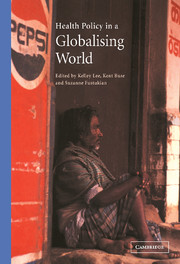Book contents
- Frontmatter
- Contents
- List of figures
- List of tables
- List of boxes
- Notes on contributors
- Foreword
- Preface
- Acknowledgements
- Abbreviations
- Part I
- Part II
- 9 Global rhetoric and individual realities: linking violence against women and reproductive health
- 10 The globalisation of DOTS: tuberculosis as a global emergency
- 11 Ageing and health policy: global perspectives
- 12 Workers' health and safety in a globalising world
- 13 Globalisation, conflict and the humanitarian response
- Part III
- References
- Index
9 - Global rhetoric and individual realities: linking violence against women and reproductive health
Published online by Cambridge University Press: 22 September 2009
- Frontmatter
- Contents
- List of figures
- List of tables
- List of boxes
- Notes on contributors
- Foreword
- Preface
- Acknowledgements
- Abbreviations
- Part I
- Part II
- 9 Global rhetoric and individual realities: linking violence against women and reproductive health
- 10 The globalisation of DOTS: tuberculosis as a global emergency
- 11 Ageing and health policy: global perspectives
- 12 Workers' health and safety in a globalising world
- 13 Globalisation, conflict and the humanitarian response
- Part III
- References
- Index
Summary
Introduction
Violence against women (VAW) and poor reproductive health are two issues that place a substantial burden worldwide on the health of women. Both are global in many ways, cutting across national, socio-economic and cultural boundaries. Both VAW and reproductive health have received substantial attention in the increasingly globalised health and development debates of the last decade. There are important connections between the two issues – VAW has a range of reproductive health consequences, and violence is frequently used to control women's sexuality and/or fertility. There have also been a number of similarities in the advocacy processes that resulted in the international recognition of both issues (including the co-ordination between and networking of national and international women's groups). There are also many potential linkages in the delivery of interventions to address both issues (most importantly, the empowerment of women)
This chapter starts by presenting evidence on the global burden of sexual and domestic violence against women, and its relationship to reproductive health. We then chart the evolution of both issues within the United Nations (UN) human rights, health and development agendas. We illustrate how the diversification of actors, the end of the cold war, and the strengthening of networks and linkages between different national and regional women's groups facilitated the development of a strong global women's advocacy movement that was able to influence the global agenda. The opportunities and potential difficulties associated with translating the resulting global rhetoric into an operational reality at the national level are discussed.
- Type
- Chapter
- Information
- Health Policy in a Globalising World , pp. 159 - 180Publisher: Cambridge University PressPrint publication year: 2002
- 1
- Cited by



